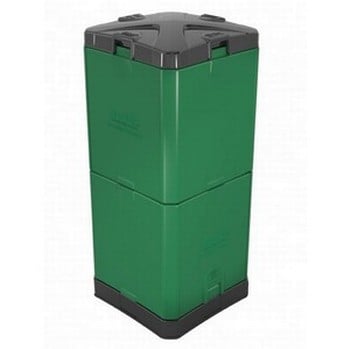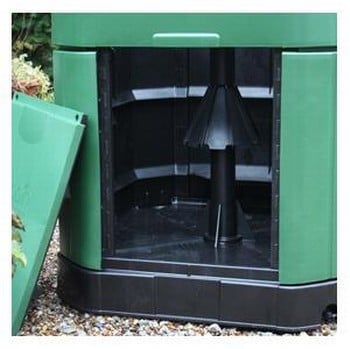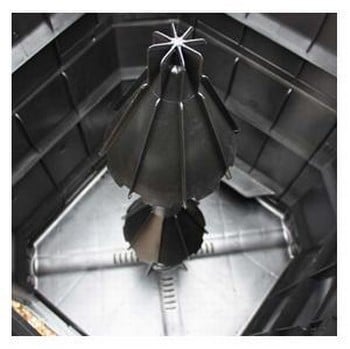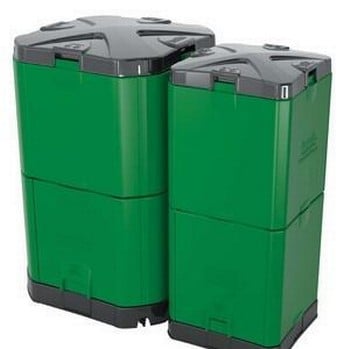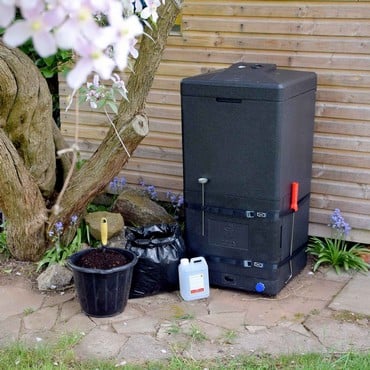Aerobin Composter 200L
The 200 litre Aerobin, has taken the age-old art of home composting into the 21st century, utilising a thoroughly efficient composting system with a patented central aeration 'lung' to radically reduce composting time
Read More
The Aerobin Composters have taken the age-old art of home composting into the 21st century thanks to a combination of modern technology, materials and manufacturing - and both you and your vegetable plot, allotment and ornamental borders will benefit from this quick, clean and thoroughly efficient composting system.
The main advantage of the Aerobin is the patented central aeration core or 'lung', which draws essential air through a base outlet through tubes to reach the centre of the heap and radically reduce the composting time. Throw in the fully insulated side panels and lid, the capacity liquid feed catchment tank complete with drain valve, removable side access door for easy compost collection and 200 litre or 400 litre capacity and you can see why the Australian-made and Eden Project-endorsed Aerobin Composters are seen as the future of composting. Compost in the Aerobin requires no turning; the bin is rodent-proof and will arrive with you flat-packed for quick and easy assembly - and the comprehensive instruction manual will help you get the most from your environmentally-friendly Aerobin.
- Aerobin 200 Litre Composter measures 51cm x 51cm x 117.5cm
- 200 litre capacity
- Net weight:- 200L = 17kg
- Insulated walls and lid allow moisture to re-circulate
- Patented internal core or 'lung' provides ventilation
- Sealed base prevents leaching of valuable liquid feed and prevents vermin entering bin
- Liquid catchment tank in base
- Tap to draw off valuable liquid feed from base tank
- Compost through winter with the fully insulated side panels and lid
- Add material daily
- Breaks material down quickly through 'hot composting'
- 3 year guarantee
- No turning of material required
- Very easy to use - no manual input
- Assembly quick and easy
- Full colour assembly instructions provided
- Additional guide on how to use also included
- Manufactured from 100% virgin polymer
Click on the images below to download even more Aerobin information!
The Brochure (left, downloadble PDF version 1.86MB) explains how the Aerobin functions and how its use can help the environment and the Instruction Booklet (right, downloadble PDF version 1.29MB) contains assembly information and how to get the most from your Harrod Horticultural-supplied Aerobin.
Product Reviews
I wanted one container,instead of three smaller ones for my compost. In about twenty minutes I had assembled this one,even though it was getting dark. I put in alternate layers of plant material and already made compost or soil,plus a sprinkling of water. On top I put a thermometer and so far it's kept a steady 20c. That's good in the cold spot it has to be in.
easy to assemble, just started using and looking forward to first batch of compost
What can go in to a conventional bin and how does it all work?
Success depends on heat, biology and a good balance of ingredients, added in approximately 10cm. layers. ‘Green’ waste (grass, border and hedge trimmings, snipped or shredded woody prunings) heats up steamily, starts to break down rapidly and can be stirred into layers below to speed everything up. ‘Brown’ waste (e.g. shredded paper, packaging and straw) should be added at regular intervals to counteract the wetness of the greenery and will rot down too. Manure from herbivores (chickens, pet rabbits) adds zest to the whole mixture, as does the odd spadeful
of soil.
Autumn leaves are best composted on their own in hessian bags or cages, since they rot down more slowly and in a different way.
What shouldn’t go in?
Moss (which refuses to rot and can therefore be unwittingly spread around)
Seeding weeds or garden thugs (i.e. Verbascums, Fennel) Roots of perennial weeds such as ground elder and bindweed – unless they are thoroughly dried off in the sun first. Cat and dog (i.e. carnivore) manure. Meat or cheese kitchen scraps or vegetable waste that has been contaminated by them.
Common problems
Too dry? Water the heap and/or add more greenery and cover it tightly to keep the heat in.
Smelly? Add more ‘brown’ ingredients, but no grass clippings or kitchen waste for a while. Stir the contents to open it up. Leave the lid off.
Rats? This is a tricky one - they may try to move in if there is a regular source of food nearby (i.e. a bird table or poultry house).
Slugs and snails? No problem. They are doing their bit for the composting process, and at least it keeps them away from your lettuces and hostas.


















